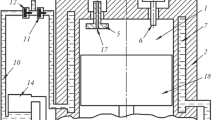A thermodynamic analysis has been performed for the operation of piston machines using ideal and real gases as a working body in direct and inverse Carnot cycles. An interrelationship has been established between the fugacity coefficient of the working body (real gas) and the efficiency of a piston thermal machine. Calculating formulas have been obtained for identifying the dependence of the efficiency of such machines on the characteristics of their working body. Verification has been conducted for the proposed method of thermodynamic potentials and the relations obtained on its basis connecting the actual efficiency of a thermal machine with the fugacity coefficient of its working body.
Similar content being viewed by others
References
V. G. Kiselev, A. A. Kalyutik, S. O. Makoev, and A. V. Fedyukin, Main trends in increasing technical and economic efficiency of underground power pipelines cathodic protection, IOP Conf. Ser.: Earth Environ. Sci., Article ID 012098 (2019).
V. G. Kiselev, A. A. Kalyutik, and E. B. Rouzich, Influence of the soil electrical conductivity in the area of the underground pipeline on energy efficiency of the cathodic protection, Proc. Int. Sci. Conf. on the Energy, Environmental and Construction Engineering, Article ID 07015 (2018).
V. G. Kiselev, A. A. Kalyutik, and M. I. Kukolev, Steel intensity of thermal machines and heat capacity of their working body, Probl. Reg. Énerg., No. 2 (46), 53–64 (2020).
A. A. Kalyutik, V. G. Kiselev, and E. B. Rouzich, Impact of the underground metal construction cover layer on the cathode protection efficiency, IOP Conf. Ser.: Mater. Sci. Eng., Article ID 022057 (2018).
V. G. Kiselev, A. A. Kalyutik, and O. Derevianko, Optimization of the amount of coke filling usage in cathodic protection systems for an anode grounding model in the form of a hemisphere, IOP Conf. Ser.: Mater. Sci. Eng., Article ID 042059 (2018).
V. G. Kiselev, V. V. Sergeev, and E. B. Rouzich, Infl uence of the electric double-layer capacitance at the rate of corrosion at the phase interface, Corrosion Rev., 35, No. 1, 47–51 (2017).
V. M. Borovkov and V. G. Kiselev, The main areas of scientifi c and technological work to control corrosion of heat supply networks, Izv. Ross. Akad. Nauk, Énergetika, No. 5, 110–119 (2006).
V. Sergeev, I. Anikina, and K. Kalmykov, Efficiency of using heat pumps with various refrigerants in real steam turbine power units with PT-80 and T-250 turbines, E3S Web Conf., December 18, 2019, 140, Article ID 10001 (2019).
M. Treshcheva, D. Treshchev, I. Anikina, and S. Skulkin, The potential for reducing TPP water consumption through the use of heat pumps, E3S Web Conf., December 18, 2019, 140, Article ID 11001 (2019).
I. Anikina and V. Suslov, Influence of heat pumps inclusion in deaeration scheme of heating network make-up water on the operating modes of the TPP, MATEC Web Conf., December 5, 2018, 245, Article ID 15004 (2018).
I. D. Anikina, V. V. Sergeev, N. T. Amosov, and M. G. Luchko, Use of heat pumps in turbogenerator hydrogen cooling systems at thermal power plant, Int. J. Hydrogen Energy, 42, No. 1, 636–642 (2017).
F. A. Amirov and E. F. Amirov, Maximum effi ciency coeffi cient of the centrifugal pumps working with the hydrodynamically active additives, Nauka Mir, 1, No. 11, 10–12 (2016).
M. Büchler and D. Joos, Wechselstromkorrosion an kathodisch geschützten Rohrleitungen, 3R Int., No. 6, 46–52 (2016).
S. Z. Sapozhnikov, V. Yu. Mityakov, A. V. Mityakov, A. V. Vintsarevich, A. V. Pavlov, and I. D. Nalyotov, Gradient heat fl ux measurement as monitoring method for the diesel engine, J. Phys.: Conf. Ser., 891, No. 1, Article ID 012096 (2017).
I. Prigogine and D. Kondepudi, Modern Thermodynamics. From Heat Engines to Dissipative Structures, Mir, Moscow (2002).
Author information
Authors and Affiliations
Corresponding author
Additional information
V. G. Kiselev is deceased.
Translated from Inzhenerno-Fizicheskii Zhurnal, Vol. 95, No. 3, pp. 583–593, May–June, 2022.
Rights and permissions
About this article
Cite this article
Kiselev, V.G., Kalyutik, A.A. & Naletov, I.D. Actual Efficiency of Piston Machines. J Eng Phys Thermophy 95, 570–580 (2022). https://doi.org/10.1007/s10891-022-02513-y
Received:
Published:
Issue Date:
DOI: https://doi.org/10.1007/s10891-022-02513-y




